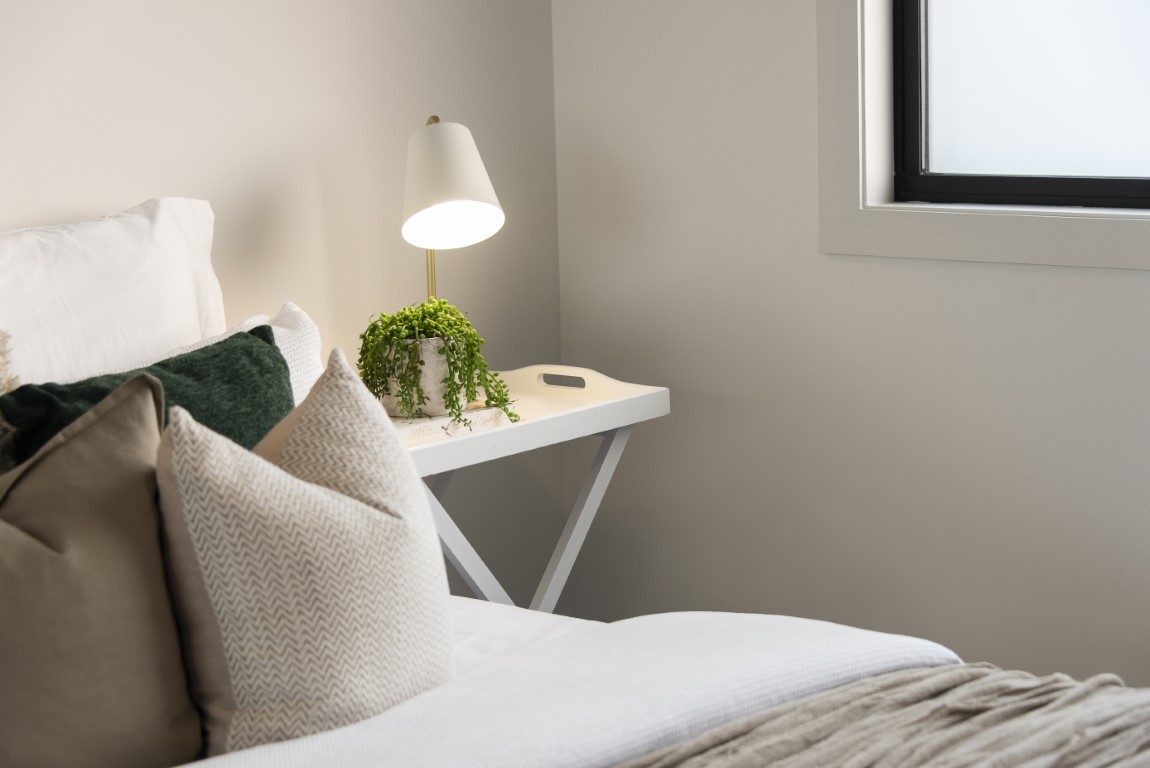Lighting is crucial in transforming small living spaces, which typically span only about 1,841 square feet in the U.S. By choosing the proper lighting, you can make these compact areas feel significantly larger and more welcoming. It’s all about finding that perfect glow that brightens your space and enhances its overall appeal, creating a cozy haven.
Lighting Types and Their Roles
Understanding the different types of light available and the unique role each plays in enhancing your living space is essential. Here are the most common types and how each can elevate a space:
Ambient lighting
Ambient lighting is the foundation of any well-thought-out lighting plan, casting an overall glow that sets the mood of your room. It provides a consistent level of light that’s comforting and practical. Whether lounging with a book or hosting friends, ambient lighting ensures your space is always inviting, blending seamlessly into the background.
Task lighting
Task lighting is essential for activities like reading a book or making a gourmet meal in the kitchen. It goes beyond functionality. This type of lighting can become a standout focal point in your space. You can illuminate your tasks with a suitable lamp or fixture and add a stylish accent that captures attention, blending practicality with aesthetics.
Accent lighting
Accent lighting is ideal for spotlighting architectural features or decor pieces that make your space unique. It adds depth and dimension, transforming flat areas into visually engaging scenes. You can draw attention to artwork, showcase collectibles, or illuminate a beautiful architectural detail by strategically placing accent lights. This method turns them into the stars of your small space.
Maximizing Natural Light
Enhancing natural light in your home makes your space look bigger and more inviting. It also improves your sleeping patterns. Use reflective surfaces like mirrors or glossy finishes to bounce light around the room. Opt for light-colored walls to softly diffuse brightness throughout your space. These simple adjustments can make a difference, filling your home with a warm, natural glow that boosts your mood and energy levels.
Moreover, selecting the appropriate window treatments can significantly influence how much natural light fills your room. Go for sheer curtains or blinds that allow you to control the amount of light entering, offering flexibility to maximize or diffuse light.
Choosing the Right Artificial Lighting
Choosing the right size and style of light fixtures ensures your small space doesn’t feel overwhelmed or cluttered. It’s about striking the perfect balance by selecting pieces that complement your area without dominating it.
For those small but significant areas like entryways, kitchens, and bathrooms, consider a chandelier from Visual Comfort & Co. Their range of pendant lighting is stylish and scaled to fit smaller spaces beautifully. These fixtures offer elegance without overpowering the room. They can direct light exactly where needed, making them a practical yet fashionable choice.
When it comes to the bulbs, opting for LEDs or CFLs can make a big difference in energy efficiency and your space’s warmth. LEDs are a fantastic option for long-lasting illumination, reducing the need for frequent replacements. Meanwhile, CFLs offer a cost-effective alternative with a slightly different light quality.
Clever Placement of Light Sources
Consider strategically placing lights at various levels, from floor lamps to table lamps and overhead fixtures. You can create an illusion of space and height, making your room feel larger and more dynamic. Directional lighting, such as track lights or adjustable wall sconces, allows you to spotlight the room’s best features, drawing the eye and adding depth.
Get creative by integrating lighting into furniture or architectural elements to save space and add a unique character to your home. This approach enhances functionality and infuses your space with a warm, inviting glow.
Using Color and Brightness to Your Advantage
The color of light in your room can dramatically affect how you perceive the space. For instance, cool tones offer a crisp, vibrant feel, while warm tones create a cozy, inviting atmosphere. White lighting, in particular, can make a space appear more spacious, functional, luminous, and clear. It casts a bright ambiance that enhances the room’s overall appeal.
Incorporating dimmers lets you adjust the lighting to match the time of day or set the mood. It gives you the flexibility to transform your space with just a flick of a switch. Consider adding colorful lighting fixtures as accent pieces for a dash of personality. These functional elements and decorative features reflect your unique style, making small spaces feel special and tailored to your tastes.
Lighting Tips for Specific Rooms
In the kitchen, under-cabinet lighting paired with overhead ambient light creates a functional and spacious feeling, illuminating workspaces without overwhelming the room. For the living room, floor lamps, table lamps, and possibly track lighting allow you to adjust the ambiance for any occasion.
Meanwhile, opt for soft, warm lighting in the bedroom to foster relaxation. Complement it with task lighting near the bed or dressing area where you need focused light. This thoughtful approach to lighting design ensures each room adapts to your daily life and ever-changing needs.
Finding Your Perfect Light
Explore various lighting options, and don’t be afraid to experiment with different solutions to discover what truly brings your space to life. Finding the perfect lighting setup can transform your home into a space that mirrors your unique taste and lifestyle.
Discover more from Futurist Architecture
Subscribe to get the latest posts sent to your email.

![modern apartment [article_title]](https://www.futuristarchitecture.com/wp-content/uploads/2025/03/Minimalist-Lighting-Ideas-for-Apartments-That-Prove-Less-Is-More-900x600.jpg)

![modern apartment [article_title]](https://www.futuristarchitecture.com/wp-content/uploads/2025/03/9-Mind-Bending-Hacks-to-Inspire-With-Abstract-Art-900x600.jpg)